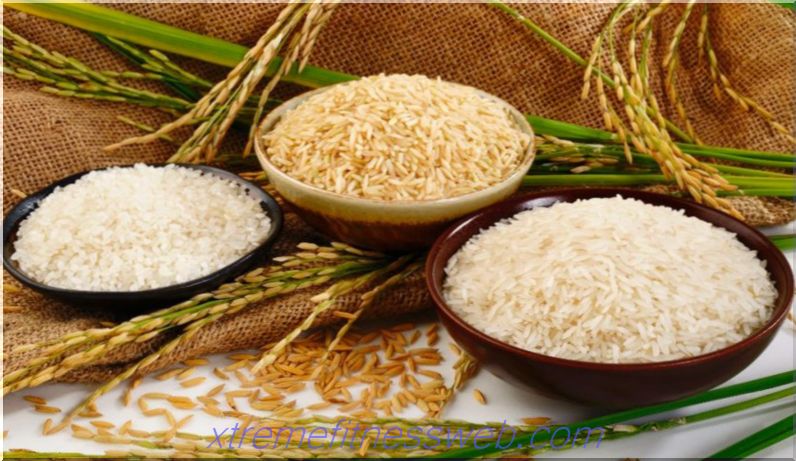- What are complex carbohydrates?
- Types of Slow Carbohydrates
- Slow carbohydrates for weight loss (porridge diet)
- The main sources of slow carbohydrates
- High Slow Carbohydrate Products

The effectiveness and efficiency of training directly depends on a balanced diet. Against the background of a lack of complex carbohydrates, the body tone and strength indicators are sharply reduced. This is especially negative for training with the use of weights, since the athlete experiences a constant lack of energy.
Content
- 1 What are complex carbohydrates "> 2 Types of slow carbohydrates
- 3 Slow carbohydrates for weight loss (porridge diet)
- 3.1 Six cereals
- 3.2 ten day
- 4 Main Sources of Slow Carbohydrates
- 5 Foods High in Slow Carbohydrates
What are complex carbohydrates?

Organic compounds related in their chemical structure to polysaccharides are called complex and slow carbohydrates. In their molecule there are a variety of monosaccharides, a lot of glucose and fructose.
Many vital processes in the body occur with the participation of monosaccharides. They contribute to the processing of fats and proteins, positively affects the liver. Food containing a large concentration of slow carbohydrates is best consumed before dinner, when carbohydrate metabolism has not yet slowed down.
The body metabolizes saccharides in the form of glucose. The speed with which saccharides are converted to glucose divides carbohydrates into simple, i.e. fast, and complex, i.e. slow. Its indicator is reflected in the glycemic index of the product. In slow ones, it is quite low, and, therefore, blood saturation with glucose does not occur irregularly, but slowly.
Products with a low glycemic index are absorbed by the body during chewing. The process starts due to the effect on the food of the enzyme contained in saliva.
Slow carbohydrates are most valuable in the winter. Thanks to saccharides, the production of such a special hormone as serotonin is stimulated. It positively affects a person’s mood, and also helps to keep the body warm.
A low glycemic index means that complex carbohydrates are absorbed for a long time. The low digestion rate eliminates insulin bursts, which provoke the processing of excess carbohydrates into fatty tissues, and, consequently, lead to obesity.
After training, the body needs a quick replenishment of the energy expended. Complex carbohydrates are absorbed for a long time. This is the main reason that eating slow polysaccharides after training is not recommended.
Foods rich in slow carbohydrates are best consumed in the morning. After awakening, an active production of glycogen occurs in the body.
Types of Slow Carbohydrates
The structure of a complex carbohydrate includes several molecular chains in which many monosaccharides are enclosed. A similar composition is characteristic of starch, glucomannan, dextrin, glycogen, cellulose, chitin. Each of these slow carbohydrate substances contains thousands and thousands of monosaccharides, which ensures a long digestion process, the energy during which is released slowly.
Carbohydrates should account for at least 50% of the total daily calories consumed. Complex recommended to use before strength training. One dose includes at least 40 grams. Slowly absorbed, it gradually and evenly provides the blood glucose level necessary for the athlete.
Due to complex carbohydrates, according to medical research, endurance indicators increase, and the fat burning process is accelerated. They maintain energy at a constant level. Eating a portion of carbohydrates, a person does not feel hunger for a long time, which is the main key to success in reducing the daily caloric intake.
There are many sources for obtaining this compound. The most common is starch. Its slow digestion in the gastrointestinal tract, accompanied by conversion to glucose, does not allow monosaccharides in the blood to fall below the mark. A large amount of starch is found in legumes and crops.
The breakdown of glycogen into glucose occurs in the liver. No additional enzymes are involved in this process. The largest amount of glycogen contains pork and beef liver, a little less - yeast cells, seafood, crayfish.
Fiber is not fully absorbed, but plays an important role. It, passing the digestive tract, helps to cleanse the body and remove cholesterol, toxins and metal salts from the intestines, and also prevents the development of putrefactive processes. By stimulating an increased separation of bile, it increases the feeling of satiety.
As a result of the breakdown of fructose, a side polysaccharide called inulin is formed. It is used as a sugar substitute for diabetics, found in artichoke and chicory.
Fiber is rich in all slow carbohydrates, which makes these compounds good for digestion. By gradually splitting, they turn into glucose, which evenly enters the bloodstream, gives a long-lasting feeling of satiety and maintains the energy balance in the body.
Slow carbohydrates for weight loss (porridge diet)

The key to weight loss is the use of foods that do not cause sudden surges in glucose in the blood, saturate for a long time. Complex carbohydrates in their structure satisfy both conditions and are present in many diets, including losing weight on cereals. They are prepared from various cereals, but not from semolina, they may contain natural honey, feta cheese fruits and berries, nuts.
Porridge is useful for weight loss due to the content of complex carbohydrates and fiber, which helps cleanse the intestines. Based on this dish, two types of diets have been developed that differ not only in duration, but also in some other features:
Six cereals
Designed for a week. A seven-day diet involves eating cereal from a certain cereal from Monday to Friday in the following order: wheat, oat, millet, barley, pearl barley, rice.
And if every day corresponds to a certain type of porridge listed above, then Sunday is a free day. On the seventh day, you can cook any of the listed cereals or all at once. Prepare porridge without salt and only on the water.
In order for the diet to have the desired effect, a few days before the start of the diet, they give up alcoholic beverages, fast food, fried and spicy foods. The amount of porridge eaten is not limited.
Ten day

It implies a complete rejection of potatoes, butter, white and red meat, fish, dairy products, sugar, bread. You can eat absolutely any cereals, except semolina. Porridge is boiled without salt, butter, sugar, not milk. Before eating, be sure to drink a glass of water.
It is allowed to add a small amount of nuts, honey or fruit to the porridge. Choose cereals at your own discretion. One and a half weeks is a rather impressive period for which the body may begin to experience a deficiency of vitamins. Avoid this allows the intake of vitamin complexes.
Any diet, including porridge, based on the use of foods rich in slow carbohydrates, can be kept at most once every six months. A more frequent periodicity can undermine health. You need to leave the diet as delicately as possible, gradually enriching the diet with additional products.
The main sources of slow carbohydrates

The highest concentration of slowly digestible organic compounds with the chemical structure of polysaccharides is present in bread and pasta, cereals and various cereals. These products are characterized by a high concentration of starch. Its splitting into monosaccharides, including glucose, occurs as a result of hydrolysis. Starch is assimilated for a long time, because it has a special molecular structure.
Bread should be consumed with caution. They are not all harmless to the figure. Compounds with a high glycemic index are present in white bread, and, therefore, the product is quickly absorbed and provokes the accumulation of fatty deposits. Only macaroni and bread for which dough was prepared from whole grains, in other words, having undergone minimal processing, are considered useful.
Corn with potatoes also contain a large amount of starch, but are products with a high glycemic index. Their use is recommended to limit, especially to those who are losing weight. Among the natural sources of starch, preference should be given to cereals and cereals from cereals. Barley, oatmeal, and buckwheat are especially valuable.
The listed cereals have the lowest GI. One serving of buckwheat, oat or pearl barley porridge allows a person to feel full for a long time, as well as full of energy and strength, which is a direct consequence of the action of slow carbohydrates.
Nuts and legumes contain much less starch, but are rich in fiber. The latter is required to maintain the normal function of the digestive system and to cleanse the body of harmful toxins and toxins.
High Slow Carbohydrate Products

They represent a fairly large group, in which starch is mainly present. A characteristic feature of such products is an unsweetened and neutral taste, which is strikingly different from what is typical for foods with fast carbohydrates.
To replenish energy, you should eat the following complex carbohydrate-rich foods:
- Rough wheat pasta.
- Wholemeal bread.
- Sugar free cookies.
- Porridge (buckwheat, rice, corn, oat, etc.).
- Legumes.
- Brown rice
- Beans are white and red.
- Soya.
- Lentils
- Turkish peas.
- Shelled Barley.
- Pearl barley.
- Dried apricots.
- Apples
- Grapefruits.
- Peaches.
- Oranges.
- Cherry.
- Pears
- Avocado.
- Spinach.
- Zucchini.
- String Beans.
- Onion.
- Pepper.
- Brussels, white, cauliflower.
- Broccoli.
- Mushrooms.
- Greenery.
- Tomatoes
Complex carbohydrates are almost the only way to replenish the energy expended without the formation of adipose tissue. They can be consumed throughout the day, but the optimal time falls on the first half or 60 minutes before the strength training. After training, it is recommended to eat already fast (simple) carbohydrates.







